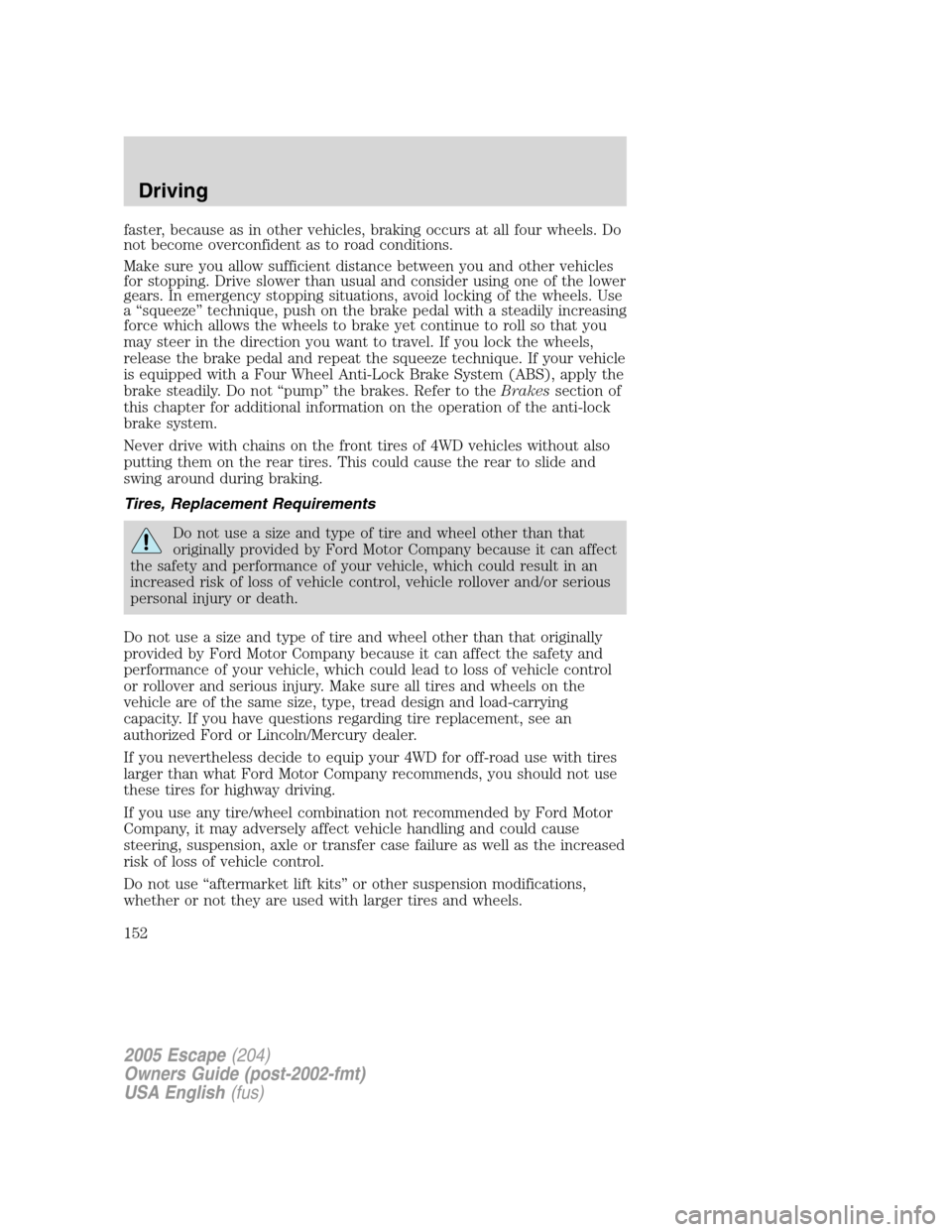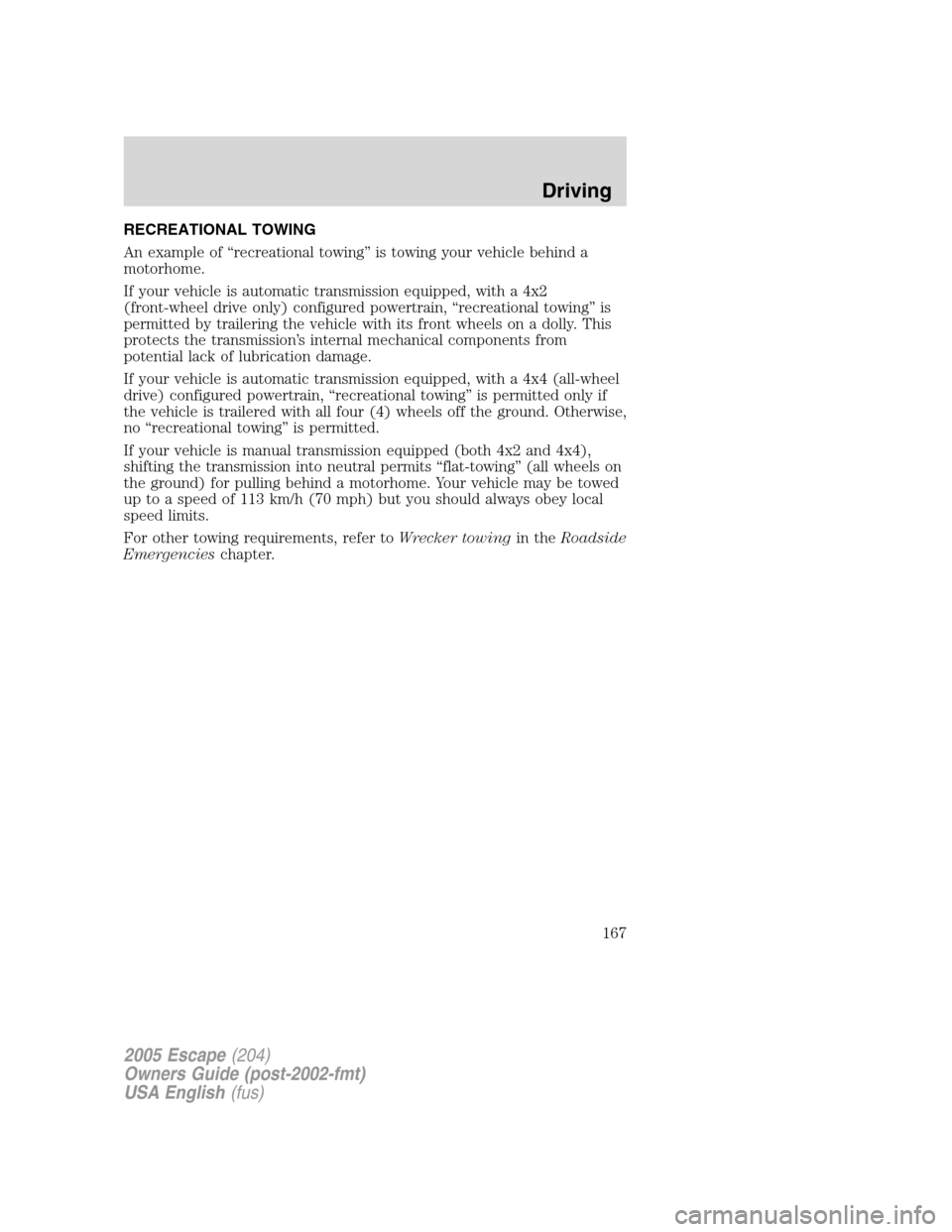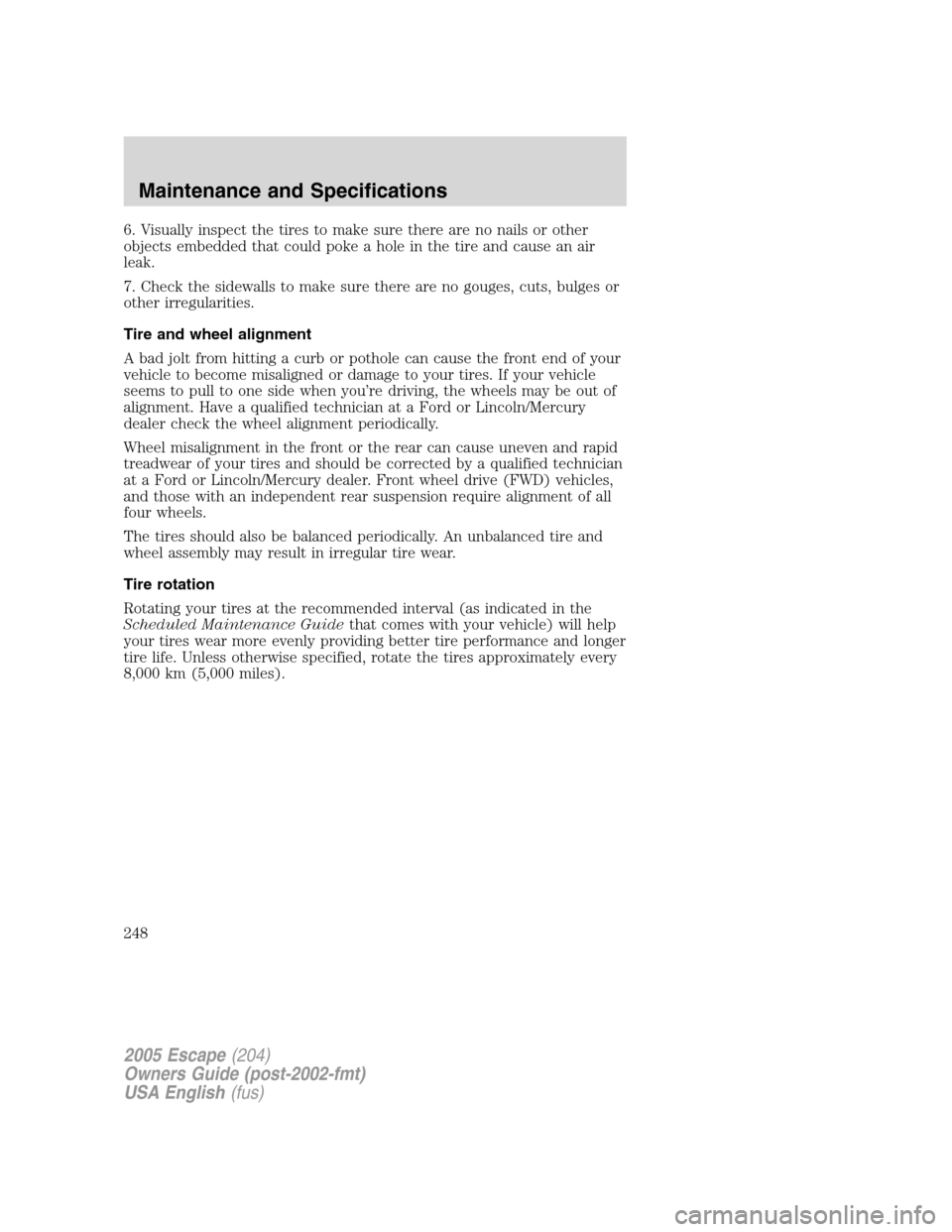Page 152 of 272

faster, because as in other vehicles, braking occurs at all four wheels. Do
not become overconfident as to road conditions.
Make sure you allow sufficient distance between you and other vehicles
for stopping. Drive slower than usual and consider using one of the lower
gears. In emergency stopping situations, avoid locking of the wheels. Use
a“squeeze”technique, push on the brake pedal with a steadily increasing
force which allows the wheels to brake yet continue to roll so that you
may steer in the direction you want to travel. If you lock the wheels,
release the brake pedal and repeat the squeeze technique. If your vehicle
is equipped with a Four Wheel Anti-Lock Brake System (ABS), apply the
brake steadily. Do not“pump”the brakes. Refer to theBrakessection of
this chapter for additional information on the operation of the anti-lock
brake system.
Never drive with chains on the front tires of 4WD vehicles without also
putting them on the rear tires. This could cause the rear to slide and
swing around during braking.
Tires, Replacement Requirements
Do not use a size and type of tire and wheel other than that
originally provided by Ford Motor Company because it can affect
the safety and performance of your vehicle, which could result in an
increased risk of loss of vehicle control, vehicle rollover and/or serious
personal injury or death.
Do not use a size and type of tire and wheel other than that originally
provided by Ford Motor Company because it can affect the safety and
performance of your vehicle, which could lead to loss of vehicle control
or rollover and serious injury. Make sure all tires and wheels on the
vehicle are of the same size, type, tread design and load-carrying
capacity. If you have questions regarding tire replacement, see an
authorized Ford or Lincoln/Mercury dealer.
If you nevertheless decide to equip your 4WD for off-road use with tires
larger than what Ford Motor Company recommends, you should not use
these tires for highway driving.
If you use any tire/wheel combination not recommended by Ford Motor
Company, it may adversely affect vehicle handling and could cause
steering, suspension, axle or transfer case failure as well as the increased
risk of loss of vehicle control.
Do not use“aftermarket lift kits”or other suspension modifications,
whether or not they are used with larger tires and wheels.
2005 Escape(204)
Owners Guide (post-2002-fmt)
USA English(fus)
Driving
152
Page 167 of 272

RECREATIONAL TOWING
An example of“recreational towing”is towing your vehicle behind a
motorhome.
If your vehicle is automatic transmission equipped, with a 4x2
(front-wheel drive only) configured powertrain,“recreational towing”is
permitted by trailering the vehicle with its front wheels on a dolly. This
protects the transmission’s internal mechanical components from
potential lack of lubrication damage.
If your vehicle is automatic transmission equipped, with a 4x4 (all-wheel
drive) configured powertrain,“recreational towing”is permitted only if
the vehicle is trailered with all four (4) wheels off the ground. Otherwise,
no“recreational towing”is permitted.
If your vehicle is manual transmission equipped (both 4x2 and 4x4),
shifting the transmission into neutral permits“flat-towing”(all wheels on
the ground) for pulling behind a motorhome. Your vehicle may be towed
up to a speed of 113 km/h (70 mph) but you should always obey local
speed limits.
For other towing requirements, refer toWrecker towingin theRoadside
Emergencieschapter.
2005 Escape(204)
Owners Guide (post-2002-fmt)
USA English(fus)
Driving
167
Page 248 of 272

6. Visually inspect the tires to make sure there are no nails or other
objects embedded that could poke a hole in the tire and cause an air
leak.
7. Check the sidewalls to make sure there are no gouges, cuts, bulges or
other irregularities.
Tire and wheel alignment
A bad jolt from hitting a curb or pothole can cause the front end of your
vehicle to become misaligned or damage to your tires. If your vehicle
seems to pull to one side when you’re driving, the wheels may be out of
alignment. Have a qualified technician at a Ford or Lincoln/Mercury
dealer check the wheel alignment periodically.
Wheel misalignment in the front or the rear can cause uneven and rapid
treadwear of your tires and should be corrected by a qualified technician
at a Ford or Lincoln/Mercury dealer. Front wheel drive (FWD) vehicles,
and those with an independent rear suspension require alignment of all
four wheels.
The tires should also be balanced periodically. An unbalanced tire and
wheel assembly may result in irregular tire wear.
Tire rotation
Rotating your tires at the recommended interval (as indicated in the
Scheduled Maintenance Guidethat comes with your vehicle) will help
your tires wear more evenly providing better tire performance and longer
tire life. Unless otherwise specified, rotate the tires approximately every
8,000 km (5,000 miles).
2005 Escape(204)
Owners Guide (post-2002-fmt)
USA English(fus)
Maintenance and Specifications
248
Page 249 of 272
•Front Wheel Drive (FWD)
vehicles (front tires at top of
diagram)
•Rear Wheel Drive (RWD)
vehicles/Four Wheel Drive (4WD)
vehicles (front tires at top of
diagram)
2005 Escape(204)
Owners Guide (post-2002-fmt)
USA English(fus)
Maintenance and Specifications
249
Page 269 of 272

Engine block heater .................133
Engine oil ..................................213
checking and adding ..............213
dipstick ....................................213
filter, specifications ........216, 253
recommendations ...................216
refill capacities ........................254
specifications ..................257, 259
Exhaust fumes ..........................133
F
Fail safe cooling ........................223
Fluid capacities .........................254
Foglamps .....................................37
Four-Wheel Drive vehicles
driving off road .......................146
indicator light .........................146
preparing to drive your
vehicle .....................................137
Fuel ............................................225
calculating fuel
economy ............................60, 229
cap ...........................................226
capacity ...................................254
choosing the right fuel ...........227
comparisons with EPA fuel
economy estimates .................232
detergent in fuel .....................228
filling your vehicle
with fuel ..................225–226, 229
filter, specifications ........229, 253
fuel pump shut-off switch .....170
improving fuel economy ........229
octane rating ...................228, 259
quality ......................................228
running out of fuel .................228
safety information relating
to automotive fuels ................225
Fuses ..................................170, 172G
Garage door opener ....................51
Gas cap (see Fuel cap) ............226
Gas mileage
(see Fuel economy) .................229
Gauges .........................................14
GAWR (Gross Axle
Weight Rating)
calculating ...............................161
GVWR (Gross Vehicle
Weight Rating)
calculating ...............................161
H
Hazard flashers .........................169
Head restraints .....................89, 91
Headlamps ...................................36
aiming ........................................39
autolamp system .......................36
bulb specifications ....................43
daytime running lights .............37
flash to pass ..............................38
high beam .................................38
replacing bulbs .........................44
turning on and off ....................36
Heating
heater only system ...................33
Hood ..........................................210
I
Ignition ...............................130, 259
Infant seats
(see Safety seats) .....................122
Inspection/maintenance
(I/M) testing ..............................234
2005 Escape(204)
Owners Guide (post-2002-fmt)
USA English(fus)
Index
269